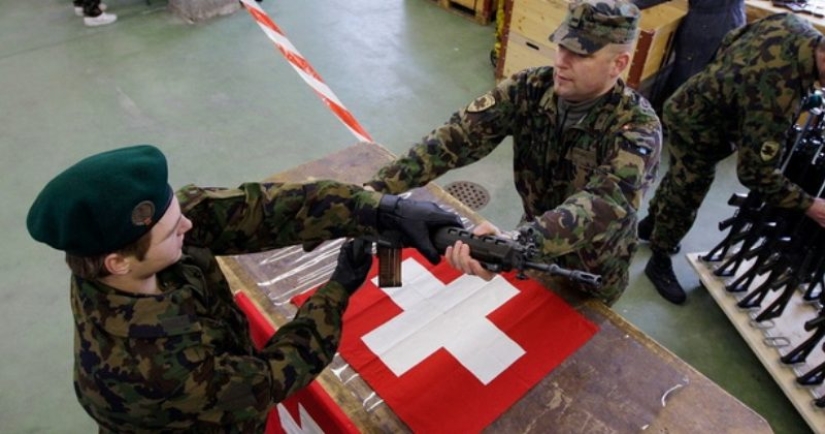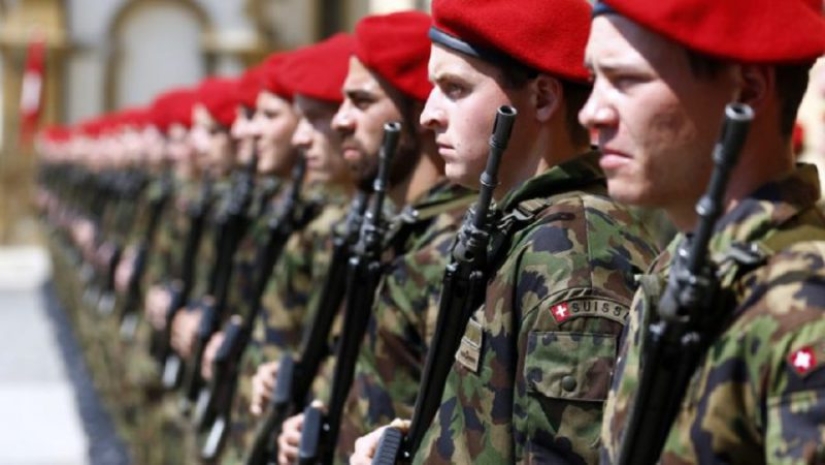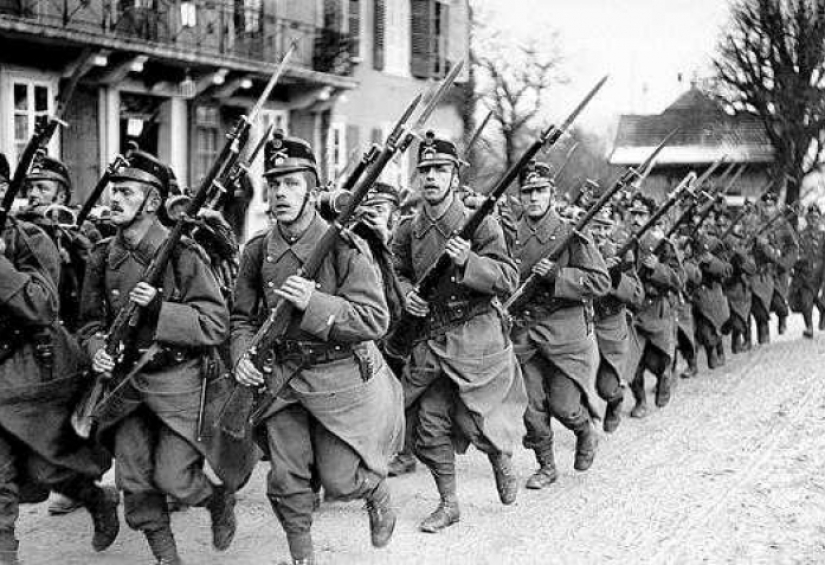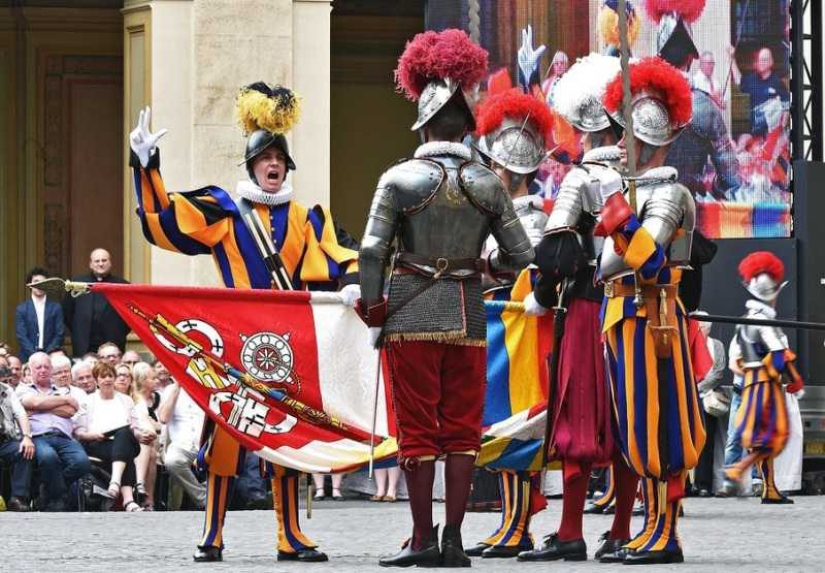Swiss Armed Forces — why does a country need an army that is not fighting
We all know that Switzerland remains neutral in military conflicts, remaining an oasis of relative peace and tranquility even during world wars. But it is also well known to everyone that the inhabitants of this seemingly peaceful country keep automatic weapons at home and without the slightest doubt use them to protect their country. How is it that a country that has avoided wars for centuries has one of the most combat-ready armies in Europe?

The Swiss army is small, but few people will want to encroach on the territory of this small country located in the heart of Europe. In just a couple of days, she can conduct an incredibly effective mobilization and put hundreds of thousands of fighters "under the gun".

Swiss mercenaries served in different armies of the world and were famous for their discipline, excellent training and loyalty, of course, for money. But the Swiss rarely had to fight to defend their country. The last time this happened was back in the era of the Napoleonic Wars.
Switzerland emerged in the 13th century as a union of self-governing and then exclusively German-speaking cantons. Because of this, in the following centuries, this political entity did not have a general army as such, and it was replaced by the militia of individual cantons, that is, the militia (from the Latin militia — militia).

In 1815, a federal treaty was concluded, according to which each canton undertook to provide combat-ready soldiers in the amount of at least 2% of the total population to the central government. The federal army appeared in the country only in 1848, and for the cantons this meant the deprivation of the right to participate in wars independently.
Each canton reserved the right to have a militia, but these military units could no longer play any role, since under the new laws their number should not exceed 300 people. At the same time, Switzerland received a general military duty for the male population, suitable for health and age.
It should be noted that the central Government of the country has never abused the right to universal mobilization. It was declared only three times: after the Franco-Prussian War, which destroyed the regime of Napoleon III in France and united Germany, as well as at the beginning of the First and The Second World War.

During the Second World War, the existence of Switzerland was in great doubt. A small state, most of whose population spoke German, was a real candidate for joining the Reich, immediately after Austria. Hitler even had a plan for this, codenamed "Tannenbaum".
Switzerland would not be able to survive in this war, so the country's government decided to play all-in. Firstly, it was necessary to show that such a military campaign would not be an easy walk, as in the case of Austria, for the Wehrmacht. And secondly, to prove your loyalty to Germany.
The mobilization was led by 61-year-old General Henri Guizan, who managed to assemble an army of 850 thousand people in just three days. They argued about how best to hold the defense against the German army for longer, but eventually came to the optimal solution. The concept of a "National Redoubt" was chosen, which implied abandoning the defense of the northern part of the country located in the foothills.

It was decided to sacrifice the industrial areas, and keep the defense in the mountainous southern regions. It was planned to transfer the government and all major state institutions there. Narrow roads, passes, bridges and tunnels had to seriously interfere with the Wehrmacht to conduct combat operations.
Hitler immediately realized that victory over the Swiss would come at too high a price and for the sake of a dubious military prize he would have to sacrifice significant resources needed in other areas. Therefore, after some hesitation, it was decided to leave Switzerland alone, at least for the first time.
Nazi propaganda immediately launched a campaign designed to justify such a decision. Switzerland was shown in the press as a backward, almost medieval country inhabited by peasant shepherds and stupid ruddy milkmaids. The Swiss government, convinced of the relative security of the country, offered the Germans the sale of goods for Reichsmark and the transit of military cargo from fascist Italy through its transalpine mountain tunnels.

Despite this, the cunning Swiss did not manage to sit out completely on the sidelines. German planes regularly violated the country's airspace and the country's Air Force repeatedly lifted its planes into the air to intercept. In total, during the war, Swiss pilots shot down 11 Luftwaffe aircraft.
But Allied and American planes were also actively attacked. 36 pilots were killed and the Allies also shot down Swiss planes in response. Once an American bomber accidentally dropped a bomb on Zurich, confusing it with the German Freiburg.
Land skirmishes took place between Swiss army units and the Wehrmacht at the borders, when the Nazis, lost in the mountains, accidentally wandered into the territory of a neutral country. In general, Switzerland's losses in The Second World War was scanty when compared with those suffered by other participants.

Most often, Swiss soldiers had to fight against their own citizens — the country's authorities did not hesitate to use troops to suppress riots and disperse rallies. The biggest clashes with protesters are considered to be the suppression of a workers' strike in 1918 and the dispersal of anti-fascist rallies in 1932, a wave of which swept across the country.
During the Cold War era, high mobilization readiness was maintained in Switzerland. The new concept of Armee 1961 adopted in the country said that the mobilization potential should be at least 625 thousand military personnel. They were mostly reservists who had undergone military training and were ready to join the ranks in the shortest possible time.
The problem of providing the mobilized with weapons was solved in a Swiss non-standard way — the demobilized took rifles and a certain amount of ammunition home with them. Thus, a citizen called up for mobilization, appeared at the gathering place already with a weapon and was immediately ready to go into battle.
But after the end of the Cold War, the Swiss government faced the question of whether the country needed an army at all. A state surrounded by EU countries and part of the Schengen area hardly needed an impressive military machine, which billions of Swiss francs were spent annually to maintain.

The Swiss searched for the answer to this question twice — in 1998 and in 2001, holding national referendums on the complete abandonment of the armed forces. Both times the advantage was on the side of those who wanted to keep the army. At the same time, it turned out that most citizens are still pacifists and they do not consider options at all that they will have to defend themselves from someone and, moreover, attack someone.
As a result, the mobilization potential of the armed forces was reduced to 400 thousand, and then to 200 thousand people. In 2018, the figure was revised again and settled on a modest 100 thousand. Currently, approximately 21 thousand soldiers and officers serve in the Swiss army. Of these, only 5 thousand can be called professionals — these are officers, instructors, pilots and other military specialists. The remaining 16 thousand are reservists undergoing training or re—training.
The Swiss ground forces include three shock formations — mechanized brigades. Two of them have a tank battalion each. There are also four territorial divisions consisting of infantry, mountain rifle, mountain rescue and engineering battalions. There are also special training units for the training of reservists.

In addition to the ground forces, Switzerland also has its own Air Force, which operates both old aircraft produced in the 50s and 60s, and modern supersonic machines. The country's military aviation also uses helicopters, mainly of European production. There has been talk for a long time about the modernization of the Air Force through the acquisition of fifth-generation F-35 fighters, but no final decision has been made yet.
Of course, there is no fleet in a country located in the depths of the continent, but the army has a lot of high-speed and well-armed boats patrolling the vast lakes of the country.
The Swiss armed forces are characterized by the absence of generals. The last person with such a rank in the country's army was the same Henri Guizan, who so deftly carried out mobilization at the beginning of the Second World War. Such a military rank appears only during periods of military threat, and in peacetime, division and brigade commanders wear the titles Divisionär and Brigadier. The commander-in-chief of the Armed Forces of the country, Thomas Sussley, holds the title of corps commander, although there are no corps in the army.

The armament of the Swiss army is an assortment of defense industry products from different countries. The ground forces use 134 German Leopard 2 tanks, 200 CV9030 CH infantry fighting vehicles manufactured in Sweden and several dozen American M113 armored personnel carriers. Own developments are represented by 6 and 8-wheeled Piranha infantry fighting vehicles and a light armored vehicle MOWAG Eagle. Almost all small arms in the country's army are products of the German—Swiss concern SIG Sauer.
Talking about the Swiss army, it would be strange not to mention the oldest military unit in the world, whose history has never been interrupted. This is the papal guard guarding the peace of the Vatican and the pontiff himself and consisting of selected Swiss fighters.

When the power of the pope was not limited to the tiny Vatican, but extended to a very vast Papal region, serious passions were burning around the holy see. The pontiff had to be properly guarded and this task was entrusted to Swiss mercenaries, as people who are ready for money for the most selfless exploits.
In 1527, protecting Pope Clement VII from the army of the Holy Roman Emperor Charles V, dozens of guards laid down their heads. These were the biggest losses in the history of the Vatican's small mercenary army, and after that there were no serious conflicts.

Now the Swiss Guard, dressed in cuirasses and helmets of the Renaissance, performs traditional ceremonial functions. But do not consider these soldiers in unusual and even funny clothes as actors. This is one of the most respected military units in Europe, which is not easy to get into.
The applicant must be an unmarried Catholic with a height of at least 174 cm, with higher education, military service experience and impeccable characterization. Spears and halberds are not the only weapons of the papal guard. Each of these soldiers is excellent with an automatic rifle and a pistol, owns an assault knife and hand-to-hand combat skills.
Interestingly, the training of the guards includes both shooting with firearms and working with a halberd and a sword. So the Papal guards have a serious advantage over the guys who remained to serve at home. Any of them, if necessary, masterfully attacks a terrorist with a cold weapon, with which he takes up guard duty.

After the assassination attempt on Pope John Paul II in 1981, even more attention was paid to the training of the guards. It is also known that each of the soldiers taking over the guard still has an assault rifle, which is hidden next to their post. So a medieval warrior will be able to change a halberd to a modern weapon in just a few seconds.
Recent articles

There are many places in the world where only the chosen ones can be. The cities of Mecca and Medina in Saudi Arabia are well known ...

This collection of photos will clearly please the little inner perfectionist who lives in each of us. It doesn't matter how much ...

If you don't feel good about the donut you ate for lunch, relax - it can get worse ... At least you didn't eat the ...